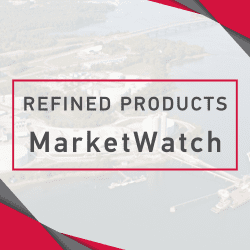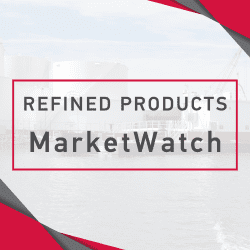Absolute (values)
Same as Flat. Reference to actual $/bbl or/gal price, as opposed to Basis values (see below)
API
The American Petroleum Institute, an industry advocacy group established in 1919 to promote the interests and development of the petroleum industry and to coordinate the industry’s interactions with the government.
Arb/Arbitrage
Strictly, the act of simultaneously buying and selling a commodity in order to take advantage of variations in normal price relationships between different time periods, commodity grades, locations or different commodities. Less formally, also used to describe the relationship between values without necessarily implying a buy/sell. Example “The distillate arb between Europe and the US is open”, meaning it is either actually or theoretically economically viable to ship distillates between the two locations.
At Market (also Market Order)
Purchase or sale at whatever price prevails at the time the transaction occurs.
At The Money
An option whose exercise or strike price is close or closest to the underlying futures price.
Back (also Outer) Months
Contract months further out in time (opposite of Front).
Backwardation/Backwardated (also Inverted)
Refers to a market where the value of a given commodity declines over forward time (opposite of Contango).
Basis
Differential between the cash or spot price of a commodity and the price of the nearest futures contract. May reflect different time periods, qualities or grades, or locations. Cash minus Futures equals Basis.
Basis Risk
Extent to which the cash/futures differential might or will change before the corresponding hedge position is fixed or liquidated.
Bear Market
Declining market.
Bear Spread
Selling near term (Front) and simultaneously buying further out (Back) in order to take advantage of a potentially falling market in which, like all commodities markets, the change is more pronounced the nearer the time frame (opposite of Bull Spread).
Book Transfer
Transfer of title without physical delivery.
Bull Market
Rising market.
Bull Spread
Opposite of Bear Spread (see above) A trading position based on simultaneously buying the Front and selling the Back to take advantage of a potentially rising market.
Call Option, Call
Option where the buyer has the right to buy a futures contract at a given (Strike) price in a specified time frame.
Cap
Supply contract with a maximum price.
Carry, Carry Market (also Contango)
Where the market value of a given commodity increases over forward time (opposite of Backwardation/Inverted Market).
Carrying Charge
Cost of storing a physical commodity. Includes interest charge, storage cost, insurance etc.
Cash, Cash Market
Often used to refer to Basis value, as opposed to Absolute value Close (also Settle) – ending value after an exchange trading session.
CFPP – Cold Filter Plugging Point
The temperature at which a fuel will cause a fuel filter to plug due to wax which has begun to crystallize or gel. The CFPP is considered by Sprague to be the true indicator of the diesel fuels low temperature operability.
Closing Range
Range of prices during a specified period at the end of a trading session.
Cloud Point
The temperature at which wax in diesel fuel becomes cloudy when it is cooled. Wax is inherent in diesel fuel. As the fuel is cooled, the wax will crystallize forming platelets that clog fuel filters. Typical diesel fuels will fail at temperatures near the cloud point. RoadForce is specially formulated to operate well below the cloud point. This is accomplished with wax crystal modifier additives that break down the wax into microscopic fragments allowing them to pass through the fuel filter.
Collar
Supply agreement where the buyer is guaranteed a maximum price and the seller a minimum price. Also where a Call and Put Option are used to achieve the same result. A Costless Collar is where buying and selling respectively the related Call and Put are used to finance the Collar.
Contract
Unit of trade on a futures exchange. For the NY Mercantile Exchange, this is 42,000 gal (1000 bbl) for gasoline, heating oil and crude oil.
Crack Spread
In petroleum, the difference in value between crude oil and the product(s) refined from it, a reflection of Refining Margin.
Current (also Front, Spot, Near, Prompt) Month
First month currently on the screen.
Degree Day
Extent to which average daily temperature exceeds/falls below 65 Deg F.
Derivative
Financial instrument based on (derived from) a physical commodity or another financial instrument. A futures contract is a derivative of a physical commodity, an option is a derivative of a futures contract.
Distillate
Generic name for kerosene, diesel fuel and heating oil.
EFP
Exchange For Physical. Strictly, an arrangement between a NYMEX supplier and receiver for delivery of a product not conforming to contract specifications. More generally, a purchase in which the physical transaction is accompanied by a corresponding exchange of futures.
Exercise
Converting an option into a future.
Exercise (also Strike) Price
Price of the conversion.
Expiration Date
Date on which a futures contract expires.
Fundamental (Analysis)
Relating to physical supply and demand (see Technical).
Gasoil
European designation for heating oil and diesel.
Hedge
The purchase or sale of a physical or futures commodity specifically to protect against price fluctuations in the same or related commodity.
Inverted Market
See Backwardated Limit Order – a NYMEX order to buy or sell futures or option with a preset maximum or minimum price.
Local
A commodity trader on the NYMEX floor buying or selling for his own account.
Long
A market position obligating the holder to take delivery unless the position is liquidated (opposite of Short).
Long Hedge
A Long futures position to protect against price increase.
Long the Basis
Where a physical long position is offset by a futures sale.
Margin
A deposit required by the exchange to insure performance.
Margin Call
A demand from the exchange for additional Margin to offset an adverse Long or Short position.
Market On Close (MOC)
An order to buy or sell at whatever price prevails at the end of the trading session.
MMBtu (also Dekatherm)
One million British thermal units, approximately equivalent to one thousand cubic feet of natural gas (MCf) and the standard NYMEX natural gas contract.
Open Interest
Refers to a Long or Short position in which there is no offsetting corresponding position. Also used generally to describe a market characterized by a high proportion of such positions.
Out of the Money
Degree to which an option’s Strike Price is distant from the corresponding futures price.
Overbought/Oversold
A mainly technical term reflecting the extent to which a market has risen or fallen too fast in relation to underlying fundamentals.
PADD
Acronym for one of five areas in the US relating to petroleum refining and supply. PADD 1 (also District 1) refers to an area covering the US East Coast.
Position
Net total of a trader’s Open contracts.
Pour Point
When diesel fuel is cooled, wax crystals agglomerate and cause the fuel to solidify. The pour point is defined as the temperature 5° F above the point at which the oil stops flowing.
Price Gap (Gap)
Where the day’s low is higher than the next day’s high (and vice versa). Used in Technical analysis to determine significant trend or price changes.
Primary Stocks/Storage
Petroleum inventories held by refiners, pipelines and major industry distribution facilities. See also Secondary and Tertiary Stocks.
Prompt
Referring to a relatively immediate action or product.
Put (Option)
An option where the holder has the right but not the obligation to sell a commodity at a given price (Strike Price) at a specified time in the future (opposite of Call).
Refinery Margin
Difference between the cost of crude and the value of the products produced from it. Also reflected by the Crack Spread applied to individual products.
Resistance
A technical reference to a price at which new selling is expected to come in and further upward price movement to encounter significant difficulty (opposite of Support).
Roll
Colloquial term for buying and selling of futures positions from one month to another.
RSI (Relative Strength Index)
A popular momentum oscillator, the RSI compares the magnitude of a stock’s or commodity’s recent gains to the magnitude of its recent losses and turns that information into a number that ranges from 0 to 100. A level of 60-70 indicates an overbought market, and >70 heavily overbought, while 40-30 indicates an oversold market, and <30 heavily oversold, with both extremes suggesting potential correction.
Secondary Stocks
Inventory held by large distributors and wholesalers, Sprague for example (see Primary Stocks).
Settle (also Close)
Official price prevailing at the end of a trading session.
Short
A market position obligating the holder to make delivery unless the position is liquidated (opposite of Long).
Short Selling
Selling a futures contract with the intention of buying back the offset at a future date or making delivery. Usually anticipates declining prices.
Short the Basis
Where a Short physical position (obligation to deliver) is offset by a futures purchase.
Spot
A onetime purchase or sale (opposite of Term).
Spot Market
Market for the immediate or prompt delivery of product.
Spread
Generally, the difference in value between different months, locations, products or product grades.
Stop/Stop Loss
An order to buy or sell at a predetermined price, in the case of Stop Loss to limit losses in an adverse position.
Straddle
Purchase and sale of offsetting futures or puts and calls to take advantage of fluctuations in intermonth price relationships.
Strike (or Exercise) Price
A specific pre-designated price at which the futures are to be bought or sold or when the option is Exercised (opposite of Market Price).
Strip
The purchase or sale of futures or physical supply over a period of months corresponding to a particular demand period.
Support
A technical reference to a price at which new buying is expected to come in and further downward price movement to encounter significant difficulty (opposite of Resistance).
Technical Analysis
Forecasting price change based on historical patterns, rates of change and changes in trading volume and open interest without regard to Fundamental market conditions.
Tertiary Stocks
Inventory held by retailers.
Volatility
Generally, the degree that exceptional price changes apply to a market. Often a reflection of markets governed by Technical factors (as opposed to Fundamentals).










